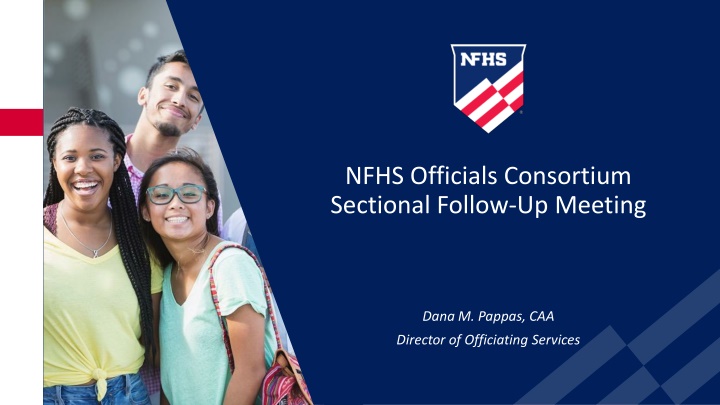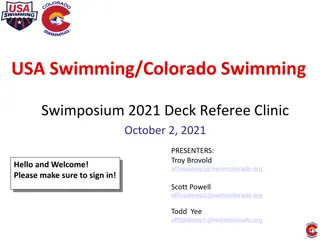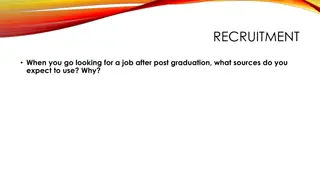Challenges in Officiating: Barriers and Solutions for Recruitment and Retention
NFHS Officials Consortium addresses the hurdles in recruiting and retaining officials in sports. Barriers include lack of support, respect, training, and unsafe work environments. Solutions aim to build a collaborative approach to enhance the officiating pipeline for stakeholders.
Download Presentation

Please find below an Image/Link to download the presentation.
The content on the website is provided AS IS for your information and personal use only. It may not be sold, licensed, or shared on other websites without obtaining consent from the author.If you encounter any issues during the download, it is possible that the publisher has removed the file from their server.
You are allowed to download the files provided on this website for personal or commercial use, subject to the condition that they are used lawfully. All files are the property of their respective owners.
The content on the website is provided AS IS for your information and personal use only. It may not be sold, licensed, or shared on other websites without obtaining consent from the author.
E N D
Presentation Transcript
NFHS Officials Consortium Sectional Follow-Up Meeting Dana M. Pappas, CAA Director of Officiating Services
NFHS Officials Consortium April 12-14, 2022 61 Attendees Officiating Leadership 42 Sport Entities/Organizations Represented Professional Collegiate Youth National Governing Bodies Coaches Associations GOAL: To identify problems and barriers to the recruitment and retention of officials and develop collaborative solutions to build and maintain the officiating pipeline for all stakeholders. 2
NFHS Sectional Follow-Up Meetings May 17 June 2, 2022 Eight meetings to held by NFHS Section. Open to administrators, coaches, officials and anyone else who wants to be a part of the solution. Recording all eight sessions so that those not able to attend can be in the know. In the interest of time, use the chat box to provide comments/feedback. We will record the chats to add great ideas to the toolkit when all sectional meetings are completed. Everyone who attends the sectional meetings will receive a copy of the toolkit. 3
Identification of Barriers (External) Behavior/sportsmanship (most common and visible issue). Lack of oversight from school administration with respect to sportsmanship; this is left to officials. Lack of training for school administrators, security, fans. No accountability for fans. Work environment unsafe, uncivil. Lack of security at youth/high school level. Lack of safe space for officials to dress, pre-game/post-game. Lack of support for officials from state associations, local associations, other governing bodies. No advocacy/celebration of officials. Lack of support for officials calls in some cases. Payment of officials/cost of officiating. Pay is not increasing with the rising cost of everything else (uniforms, equipment, gas, etc.). Lack of timeliness in payment. Multiple dues, multiple uniforms, multiple background checks for officials working various levels. 4
Identification of Barriers (External) Lack of respect for the role of an official, what officials go through to be an official. Lack of empathy and compassion for officials by coaches/fans/media. Lack of support from media as to the decisions of officials, lack of training for media. Rules and mechanics variation between levels. Scheduling of games times are impossible for officials with careers. Local level clubs and youth directors do not want officials to enforce rules (i.e., ejections when needed) because there is no emphasis on sportsmanship. Varying standards for different organizing groups. Unrealistic expectations of officials by coaches, fans perfection. Social media highlighting bad calls. 5
Identification of Barriers (Internal) Assignment issues ( good old boys systems and more). Assignors using their favorites; advancement and assignment not merit based. Process is not transparent. Expectations of officials are not clearly delineated. Supervisor (teaching, educating, training) vs. Assignor (puts officials on games). Lack of training for assignors. Lack of diversity in assignments. Putting officials on games they are not ready for, just to cover the game. Insufficient training/education of officials. Lack of soft skills in training verbal judo, de-escalation, communication, conflict resolution. What are we teaching them prior to putting them on their first game? Need to focus more on the art of officiating, in addition to the science (rules and mechanics). Lack of proper mentorship. Difficulties connecting with/relating to younger officials. Officials not supporting other officials causes a lack of trust. 6
Identification of Barriers (Internal) Lack of infrastructure/inadequate staffing to support the administration of officials at the state level. No designated director of officials or the person who works with officials has other job duties and cannot dedicate 100% to officials. Lack of evaluations/feedback/observations for officials. Not doing a good job of outreach to current high school and college students to recruit them into officiating. Lack of targeted recruitment of women and minorities. Burnout from too many assignments. Lack of pride and professionalism by officials. Assignors gauging officials with booking fees. Lack of collaboration between entities. 7
Identification of Solutions - BEHAVIOR NFHS Behavior Campaign bigger than sportsmanship (respect of human beings who officiate, focus needs to be on kids). NFHS to launch campaign, all stakeholders invited to be a part of it. Build awareness through social media; create social media frenzy that cannot be ignored. Best practices for implementation, sanctions, language, etc. Call to action every stakeholder pushes out national campaign to their constituents. Partnership among all parties sports organizations, state associations, youth sports, NGB s, coach and administrator alliances. Support among each other is critical. Creation of ZERO TOLERANCE policy across all levels. No longer room for three strikes. Deal with violators swiftly and severely so we can focus on the 90% doing things the right way instead of the 10% causing all of the problems. Call to action each entity submits their zero-tolerance policy to the NFHS to compile. Promotion of these policies on social media. PSA s featuring those being negatively impacted by behavior (student-athletes, youth athletes). Let the young people have a voice it is their game that is at risk. Every event includes this message. Included in pre-season parent meetings. 8
Identification of Solutions - BEHAVIOR Training of administrators and security as to their role in behavior. What goes on in the stands is NOT the responsibility of the officials. How to identify problems, what to look for. Administrators need to define expectations of coaches, players, fans and must define consequences for not meeting those standards. Use of influencers from professional and collegiate sports to deliver the message about spectator behavior at all levels. PSA s addressing how the fans in stands are causing officials shortages, how that effects youth sports. RESPECT THE GAME Facilities that are reported by officials as having sportsmanship and security issues must submit an improvement plan to their respective governing body before officials will return to their facility. Reteaching respect. Training media relative to the role of officials and how they can help to support instead of scrutinize. People think that media personalities are officiating experts, even when they aren t. Giving their opinions breeds negativity. 9
Identification of Solutions - BEHAVIOR Collaboration and shared expense of creation of PSA s and other behavioral campaigns. It is everyone s problem. Everyone should chip in. Getting the bosses on board Executive Directors/CEO s, superintendents, principals, AD s, other organizational leads. Educate what officials do and what they go through to certify. Cost of officiating. Present at conferences about officiating crisis and the role they play. Make kids the ones to lead the effort! Student sections cheer for officials, champion good behavior. Kids give messages about parent behavior (i.e., my dad is embarrassing me). Officials ambassadors Students welcome officials to game site, escort them onto the court. 10
Identification of Solutions - RECRUITMENT WHY Become an Official campaign. Promote the positive in officiating. Accentuate the WHY. Promote the family of officiating. Call to action collect each entity s strongest WHY, compile video testimonials, publicize. Train younger officials in volume course offering as part of curriculum at high school, JC, collegiate levels. Models Indiana and Ohio. Increase initial recruitment with training; also leads to retention when properly trained and mentored. Getting youth involved in officiating may help with empathy toward officials. Grow next generation of leaders. Standardized curriculum. Call to action market the course opportunity, with support from NFHS. Targeted recruitment for women, minorities. Outreach to high school and college students. Outreach to military (Battlefields2Ballfields, Wounded Warrior Umpire Academy). 11
Identification of Solutions - RECRUITMENT Officiating as a pathway (transferable skills) AND as a way to be a lifelong athlete. Sharing resources get all resources in the same place and make them available to the public. Personal invitation to officiating is necessary. Finding audience that is willing and reach out from there. Build your army. Let go of what you think is yours and bring everyone in. Don t worry about someone taking your games plenty to go around. Shift from me to we. Officials invited to parent pre-season meetings in their states to talk about rules and rules changes and to encourage parents to stay involved in a sport after their kids graduate. Also, helps to build relationships and humanize officials (retention). 12
Identification of Solutions - RETENTION Partnerships between officiating, coaching, administrative entities and all levels of sport. Improved relationships with coaches are necessary. Creating face-to-face opportunities outside of the game setting. Addressing assignor issues. Building awareness within organizations/associations of issues with good old boy systems. Training of assignors with regard to transparency of process, creation of opportunity for officials, meritorious assignments and advancement, diversity in assignments. Replacing ineffective assignors. Focus on the importance of mentorship creation of formalized mentoring system. Better training/education of officials. Standardization, curriculum. Soft skills training communication, conflict resolution, game management. Treatment/recognition of officials. Celebration of accomplishments and milestones from state and national level. Humanization of officials (Brenda Hilton Officially Human). Thank you s, birthdays, years of service. Compile list of these efforts in NFHS office to share with all groups. 13
Identification of Solutions - RETENTION National legislative items officials assault legislation, taxation issues. Evaluation of officials. Creating a safe environment for officials dressing room, parking, security (before, during and after game). Training all stakeholders as to the importance of their role in the improvement of the sport environment. Administrators, coaches, security, spectators. Financial issues. Using national data to set pay schedules. Making sure states regularly review pay to keep up with rising cost of uniforms, equipment, gas, etc. Find ways to use one background check for all levels. Finding partnerships with uniform/equipment vendors for first year officials. Giving stipends or discounts to officials who reach certain years of service. 14
Identification of Solutions - RETENTION Incentives for officials who continually give back (we tend to ask the same people for help all the time). Talk to new officials about where they want to go, goals, mentors. Do check-in s to make sure they are being properly fostered through the process. Accepting experience from out-of-state officials to start them at a comparable level in your state. Sharing resources get all resources in the same place and make them available to the public. Mental health resources for officials. Getting the bosses on board Executive Directors/CEO s, superintendents, principals, AD s, other organizational leads. Educate what officials do and what they go through to certify. Cost of officiating. Present at conferences about officiating crisis and the role they play. 15
Post-Consortium Next Steps Sectional follow-up meetings online (now in progress). Development of toolkit based upon Consortium and follow-up meeting findings, to be sent to all state associations, NGB s and other entities interested in being a part of the solution. Consortium 2.0 Invite leaders from coaching and administration to discuss findings, present toolkit, solutions and what they need to do to help. The work is just beginning. We need to work together! 16
Questions/Comments? Dana Pappas dpappas@nfhs.org 17























